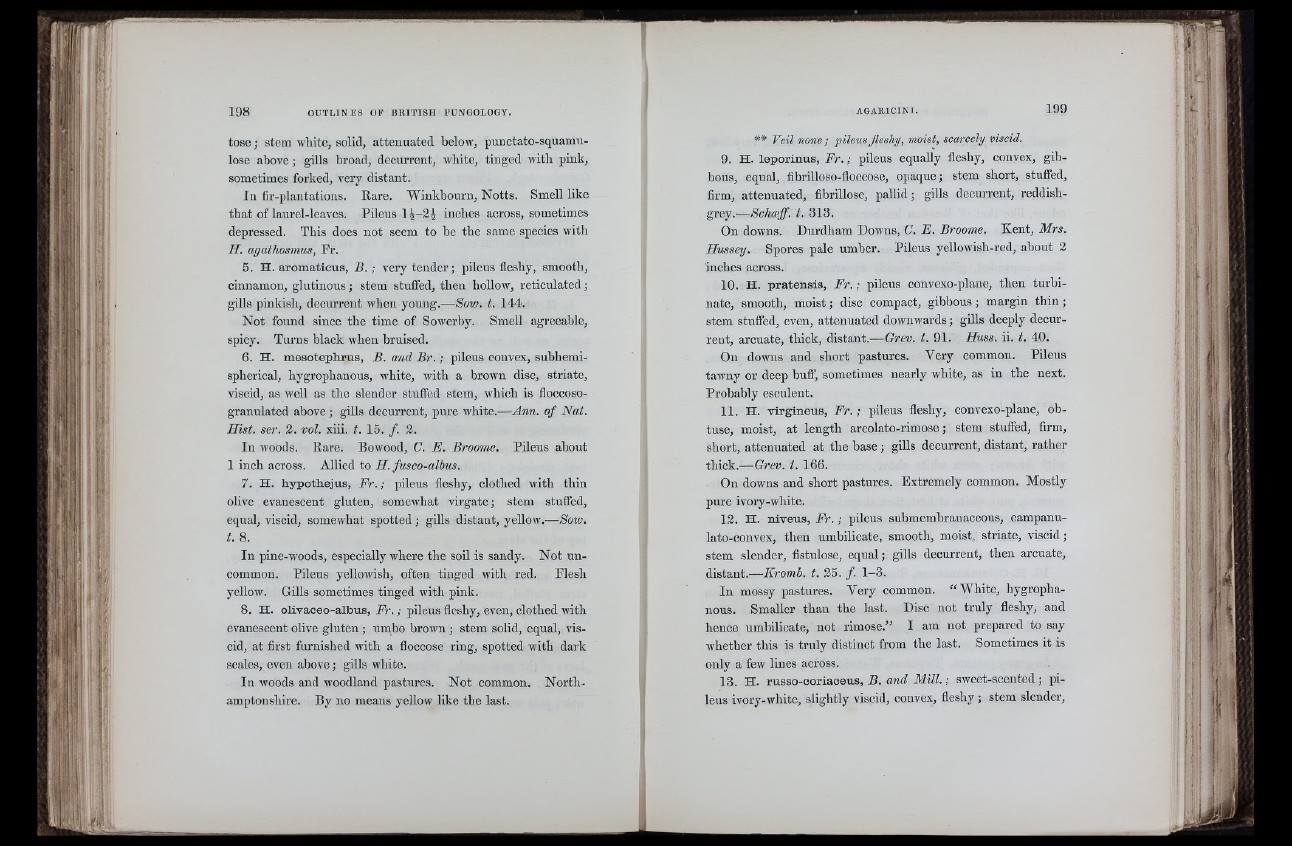
tose; stem white, solid, attenuated below, punctato-squamii-
lose above; gills hroad, decurrent, white, tinged with pink,
sometimes forked, very distant.
In fir-plantations. Rare. Winkbourn, Notts. Smell like
that of laurel-leavcs. Pileus l^ - ^ i inches across, sometimes
depressed. This does not seem to be the same species with
H. agathosmus, Pr.
5. H. aromatious, B . ; very tender; pileus fleshy, smooth,
cinnamon, glutinous; stem stuffed, then hollow, reticulated ;
gills pinkish, decurrent when young.—Sow. t. 144.
Not found since the time of Sowerhy. Smell agreeable,
spicy. Turns black when bruised.
6 . H. mesotephrus, B. and B r .; pileus convex, subhemi-
spherioal, hygrophanous, white, with a brown disc, striate,
viscid, as well as the slender stuffed stem, which is floccoso-
granulated ahove; gills decurrent, pure white.—Ann. of Nat.
Hist. ser. 2. vol. xiii. t. 15. / . 2.
In woods. Rare. Bowood, C. E. Broome. Pileus about
1 inch across. Allied to H. fusco-albus.
7. H. hypothejus, F r .; pileus fleshy, clothed with thin
olive evanescent gluten, somewhat virgate; stem stuffed,
equal, viscid, somewhat spotted ; gills distant, yellow.—Sow.
t. 8 .
In pine-woods, especially where the soil is sandy. Not uncommon.
Pileus yellowish, often tinged with red. Flesh
yellow. Gills sometimes tinged with pink.
8 . H. olivaceo-albus, F r .; pileus fleshy, even, clothed with
evanescent olive gluten; uinbo brown ; stem solid, equal, viscid,
at first furnished with a floccose ring, spotted with dark
scales, even above; gills white.
In woods and woodland pastures. Not common. Northamptonshire.
By no means yellow like the last.
** Yeil none; pileus fleshy, moist, scarcely viscid.
9. H. leporinns, F r .; pileus equally fleshy, convex, gibbous,
equal, fibrilloso-floccose, opaque; stem short, stuffed,
firm, attenuated, fibrillose, pallid; gills decurrent, reddish-
grey.—Schmff. t. 313.
On downs. Durdham Downs, C. E. Broome. Kent, Mrs.
Hussey. Spores pale umber. Pileus yellowish-red, about 2
inches across.
10. H. pratensis, Fr.; pileus convexo-plane, then turbinate,
smooth, moist; disc compact, gibbous; margin thin ;
stem stuffed, even, attenuated downwards; gills deeply decurrent,
arcuate, thick, distant.—Grev. t. 91. Huss. ii. t. 40.
On downs and short pastures. Very common. Pileus
tawny or deep huff, sometimes nearly white, as in the next.
Probably esculent.
11. H. virgineus, F r .; pileus fleshy, convexo-plane, obtuse,
moist, at length areolato-rimose; stem stuffed, firm,
short, attenuated at the base ; gills decurrent, distant, rather
thick.—Grev. i. 166.
On downs and short pastures. Extremely common. Mostly
pure ivory-white.
12. H. niveus, F r .; pileus suhmemhranaceous, campanulato
convex, then umbilicate, smooth, moist, striate, viscid;
stem slender, fistulöse, equal; gills decurrent, then arcuate,
distant.—Kromb. t. 25. / . 1-3.
In mossy pastures. Very common. “ White, hygrophanous.
Smaller than the last. Disc not truly fleshy, and
hence umbilicate, not rimose.” I am not prepared to say
whether this is truly distinct from the last. Sometimes it is
only a few lines across.
13. H. rnsso-coriaceus, B. and M ill.; sweet-scented; pileus
ivory-white, slightly viscid, convex, fleshy ; stem slender.
ri; ¡2